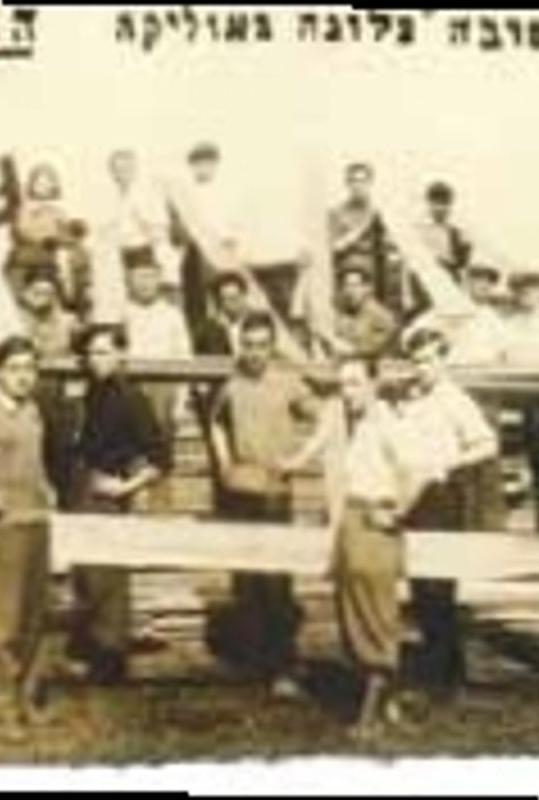The oldest surviving source reference to Izbica dates back to 1419. In 1750. The owner of the estate, Antoni Granowski, received a privilege from King Augustus III Sas to establish the town and bring Jews to it from nearby Tarnogóra, where in 1744. They were ordered to leave the city. Izbica was an entirely Jewish town from the beginning, which was a rarity in the entire Republic. Since 1835., with the construction of the highway connecting Lublin and Zamosc, Izbica developed economically and demographically and quickly became one of the more important local trade and craft centers. In 1863. The city burned down, while in 1869. It lost its municipal rights. In the second half of the 19th century. on the outskirts of Izbica began to settle an agricultural Christian population, which slightly changed the character of the settlement.In 1917. A railroad line ran through the settlement. Since 1919, Izbica was the seat of the municipal office, while in 1929. - Also the seat of the Tarnogóra municipality. September 4, 1939. It was bombed and partially destroyed by German aviation.Jews in Izbice - Until 1918. - Jews had been settling in Izbica since the mid-1840s. In 1750. Antoni Granowski was granted a privilege by King August III to found the town of Izbica and bring to it the Jews removed by a 1744 judgment of the assessor's court. from nearby Tarnogóra, which holds the De non tolerandis Judaeis privilege. Although the privilege stipulated that expelled Jews could not cross the bridge leading from Izbica to Tarnogóra under threat of imprisonment, Jews moved to Izbica in succession. As late as 1778. There were 15 Jews living in Tarnogóra, in 1781. - 13.Probably about. 1754 r. A cemetery was established in Izbica, in 1781. - wooden beit ha-midrash, and in 1775 Izbica already had the status of an independent municipality. In the 19th century. The main sources of income for Izbica's Jews were trade and crafts.The town had a water mill and a sawmill. Under the management of the community were a brick synagogue (built in 1855 to replace an earlier wooden beit ha-midrash), a cemetery, a mikveh and a ritual slaughterhouse.In the 1840s. Izbica became an important center of Hasidism, which contributed to the economic development of the center.The main sources of income for Izbica Jews were trade and crafts. The city had a water mill and a sawmill, a furniture factory, a tannery and a comb factory.From the beginning of the 20th century. Zionist and socialist movements were developing in the settlement. During World War I, Izbica was largely destroyed, and the number of its residents also decreased.Interwar Period - At the beginning of the 1920s, Izbica was a small provincial shtetl, inhabited by a poor Jewish population of more than 90%. In addition to the synagogue, cemetery, mikvah and ritual slaughterhouse, there were several private beit ha- midrash.In subsequent years, due to Christian settlement, the percentage of Jews in the population of the settlement gradually decreased. There were Jewish artisan workshops, mainly tailors, as well as numerous stores in the market square and on the main street. Lubelskaya.Six mills belonged to Jewish owners. The poor population was supported by the Joint and Linas ha-Cedek, as well as Izbica-born Jews living in the United States. In 1924. Jewish Cooperative Bank was established, there was also a Mutual Credit Society and a Loan and Savings Society.Jewish organizations and political parties developed. Among others, the following had their representation. Aguda, Mizrachi, the Zionist Organization, the Bund, the Jewish People's Party, as well as youth organizations including. He-Chaluc and Bejtar. Among socio-cultural institutions, the Kultur-Liga, operating under the auspices of the Bund, and the Tarbut association with a Zionist profile were particularly active.In 1930. The T. K. Library was established. I. L. Peretz. Care for the sick was provided by the Bikur Cholim brotherhood.In 1917. An orphanage for Jewish children was established, financed by members of the local community. There were several private cheders, a communal Talmud-Torah, and since 1931. - Polish common school, which was also attended by Jewish children. In the interwar period, Tzvi Rabinovich, a tzaddik from the dynasty of Symcha Binema of Przysucha, held his court in Izbica, and there was also a large group of followers of the tzaddik from Gora Kalwaria.
1. Izbica - Centrum miejscowości
Stories
Izbica - center of the village
Jewish History Tours

Powered by Clio Muse Tours
Powered by Clio Muse Tours
